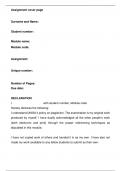Assignment cover page
Surname and Name:
Student number:
Module name:
Module code:
Assignment:
Unique number:
Number of Pages:
Due date:
DECLARATION
I with student number, Module code
Hereby declares the following:
I understand UNISA’s policy on plagiarism. The examination is my original work
produced by myself. I have dually acknowledged all the other people’s work
(both electronic and print) through the proper referencing techniques as
stipulated in this module.
I have not copied work of others and handed it in as my own. I have also not
made my work available to any fellow students to submit as their own.
,1) Learners Perspectives on School Discipline
Learners with behavior problems are described as those who behave in ways impinging on
another’s right to learn, instigating off task behavior and those who violate societal norms and
rules (Danforth & Smith, 2005:245; Rosenberg, Wilson, Moheady & Sindel, 1997: 59;
Kourkoutas & Wolhuter, 2013:3). In this light, discipline in a school is said to be the practice
of training people to obey rules and societal norms. Discipline is “a code of controlled
behavior, the orderly management and control of educational practices” (Egwuonwu, 2008:2).
There are different ways of maintaining discipline (Kourkoutas & Wolhuter, 2013). Each way
approaches behavior problems from a different perspective with the aim of helping to rectify
such behavior.
According to Tungata (2006:1), Chepkilot and Kiprop (2011:270), Yuanshan et al. (2011:1),
Maphosa (2011:245) and Clark (2001:1) the incidence of disruptive behavior in schools is
becoming more and more of a challenge for educators. However, even amongst educational
stakeholders, there seems to be disagreement about what discipline entails, what constitutes
disruptive behavior and which strategies are best in terms of dealing with undisciplined
learners. This study explores learners' opinions about school discipline within our specific
context, shedding light on their experiences, perceptions, and suggestions for improvement.
2) Information Generation
Interviewing is the predominant mode of data or information collection in qualitative research.
Researchers obtain information through direct interchange with an individual or a group that
is known or expected to possess the knowledge they seek (DePoy & Gilson 2008: 108). The
interview is a social relationship designed to exchange information between the participant
and the researcher. The quantity and quality of information exchanged depend on how astute
and creative the interviewer is at understanding and managing the relationship (Monette,
Sullivan & DeJong 2005: 178). Seidman (1998: 1) states that one interviews because one is
interested in other people’s stories. All interviews are interactional events, and interviewers
are deeply and unavoidably implicated in creating meanings that ostensibly reside within
participants.
Interviewing techniques and tips for the researcher
During interviewing, the researcher should apply the following interviewing techniques and
tips to ensure an effective interview (Jarbandhan & Schutte 2006: 674; adapted from Seidman
1998: 63–77):
The participant must do 90 per cent of the talking. An interview is not a dialogue. The
whole point is for the participant to tell the story.
, Ask clear and brief questions. It is important to use words that make sense to the
participants. Questions should be easy to understand, short and devoid of jargon.
• Ask single questions. Ask one question at a time.
• Ask truly open-ended questions. These do not predetermine the answers and they allow
room for the participants to respond in their own terms. Ask questions that require more
of an answer than “yes” and “no”.
• Avoid sensitive questions. The participant might feel uneasy and adopt avoidance tactics
if the questioning is too deep without the necessary rapport.
Purposive sampling
In purposive sampling a particular case is chosen because it illustrates some feature or
process that is of interest for a particular study – though this does not simply imply any case
we happen to choose (Silverman 2000: 104). Marlow (2005: 144) refers to this kind of
sampling as typical case sampling in qualitative research where typical cases are sought and
selected for the study. Purposive sampling is also seen by some as judgmental sampling
(Rubin & Babbie 2005: 247). This type of sample is based entirely on the judgement of the
researcher, in that a sample is composed of elements that contain the most characteristic,
representative or typicalattributes of the population that serve the purpose of the study best
(Grinnell & Unrau 2008: 153, Monette, g 2005: 148).
In purposive sampling the researcher must first think critically about the parameters of the
population and then choose the sample case accordingly. Clear identification and formulation
of pre-selected criteria for the selection of respondents is, therefore, of cardinal importance
(Maree 2007: 79). Creswell (2007: 125) adds that this form of sampling is used in qualitative
research and that participants and sites are selected that can purposefully inform an
understanding of the research problem of the study. The search for data must be guided by
processes that will provide rich detail to maximise the range of specific information that can
be obtained from and about that context (Erlandson et al. 1993: 33). In the case of purposive
sampling researchers purposely seek typical and divergent data.
3) Problem statement
Tungata (2006:16) and Yuanshan et al. (2011:4) provide various alternative forms of
disciplining learners, such as involving parents, removing privileges, time outs, reward and
punishment, role modelling, detention, manual work, empathetic relationship, demerits,
humor, verbal and non-verbal interventions, suspension or expulsion. The school educators
employ various techniques, but as a school a system of demerits, detentions and
suspensions prevails. Each educator has his/her own method of classroom discipline; some




